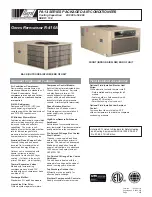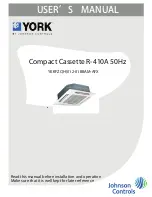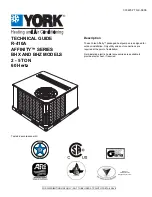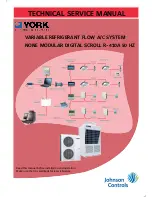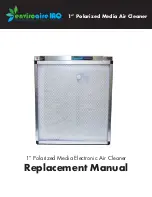
4-11
T-288
Position
1/3 of
blade
height
below
shroud.
1
2
3
4
5
6
7
1. Condenser Coil
2. Fan Blade Hub
3. Retaining Set Screw
4. 5/16 Ratchet Wrench
5. Fan Blade
6. Shroud
7. Fan Blade Guard
Figure 4-9. Condenser Fan Motor Removal
4.16 SERVICING THE EVAPORATOR FAN
BLOWER MOTOR ASSEMBLY
a. Removing, Disassembling and Assembly
1. Switch the rear control switch to the OFF
position.
2. Disconnect the wire leads to the junction box of
the
motor.
Mark
the
leads
for
proper
reassembly. It is not necessary to disconnect
the wire leads when moving the motor
assembly to replace the heater coil.
3. Remove motor mounting bolts to the bottom
panel.
4. Loosen the four venturi mounting nuts. Turn
clip and slide assembly out of the blower
housing.
5. Loosen the two blower hub set screws to
remove blower.
6. To reassemble, reverse the above procedure.
Position blower 1/16 inch overlapping venturi.
(See Figure 4-10.)
1/16-inch
1
2
3
4
5
6
1. Blower Housing
2. Fan Blower
3. Unit Frame
4. Venturi Clip Bolt
5. Venturi
6. Evaporator Motor
7. Hub Set Screw
7
Figure 4-10. Evaporator Fan Blower Assembly
4.16.1 Routine Examination and Cleaning
a. At regular maintenance periods, remove brush
covers and clean and examine motor interior.
b. Remove all foreign material, such as dirt and
carbon dust from with dry compressed air.
Clean by suction if possible to avoid blowing
foreign matter into the motor.
c. Confirm free moving brushes to prevent
binding.
d. Examine brush wear and general condition. If
brushes
are
broken,
cracked,
severely
chipped, or worn to 1/3 the length of a new
brush, replace them. Refer to section 4.16.2.
e. Examine the condition of the brush springs. A
discolored spring is a sign of overheating
which may weaken the spring, in which case
the spring should be replaced.
f.
Observe the condition of the commutator and
the armature coils that are visible.
4.16.2 Brush Replacement
If brushes are broken, cracked, severely chipped,
or worn to 1/3 their original length, replace the
brush lead assembly.
NOTE
Due to limited access on some brush
covers, it may be necessary to loosen
motor hold down bolts and rotate motor to
gain workable access to brush holders.
Summary of Contents for Carrier TRANSICOLD 68RM35-604-20
Page 1: ...T 288 Rearmount 68RM35 604 20 R 134a NYCDOT...
Page 20: ...2 3 T 288 Figure 2 2 Automatic High Speed Cool Mode Operation with Reheat TDR 10 SEC...
Page 21: ...2 4 T 288 Figure 2 3 Automatic High Speed Cool Mode Operation No Reheat TDR 10 SEC...
Page 22: ...2 5 T 288 Figure 2 4 Automatic High Speed Heat Mode Operation Below 45_F Ambient TDR 10 SEC...
Page 43: ...5 3 T 288 Figure 5 2 Electrical Schematic Diagam Based on Drawing 68RM35 1038 12 TDR 10 SEC...


























